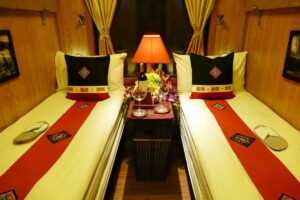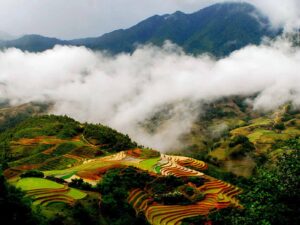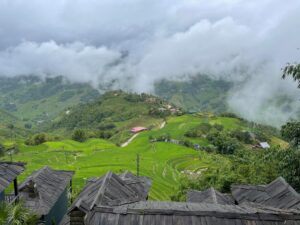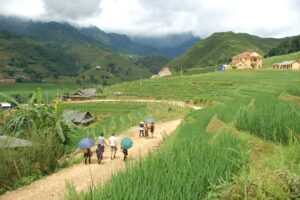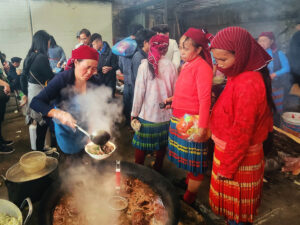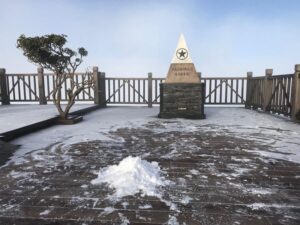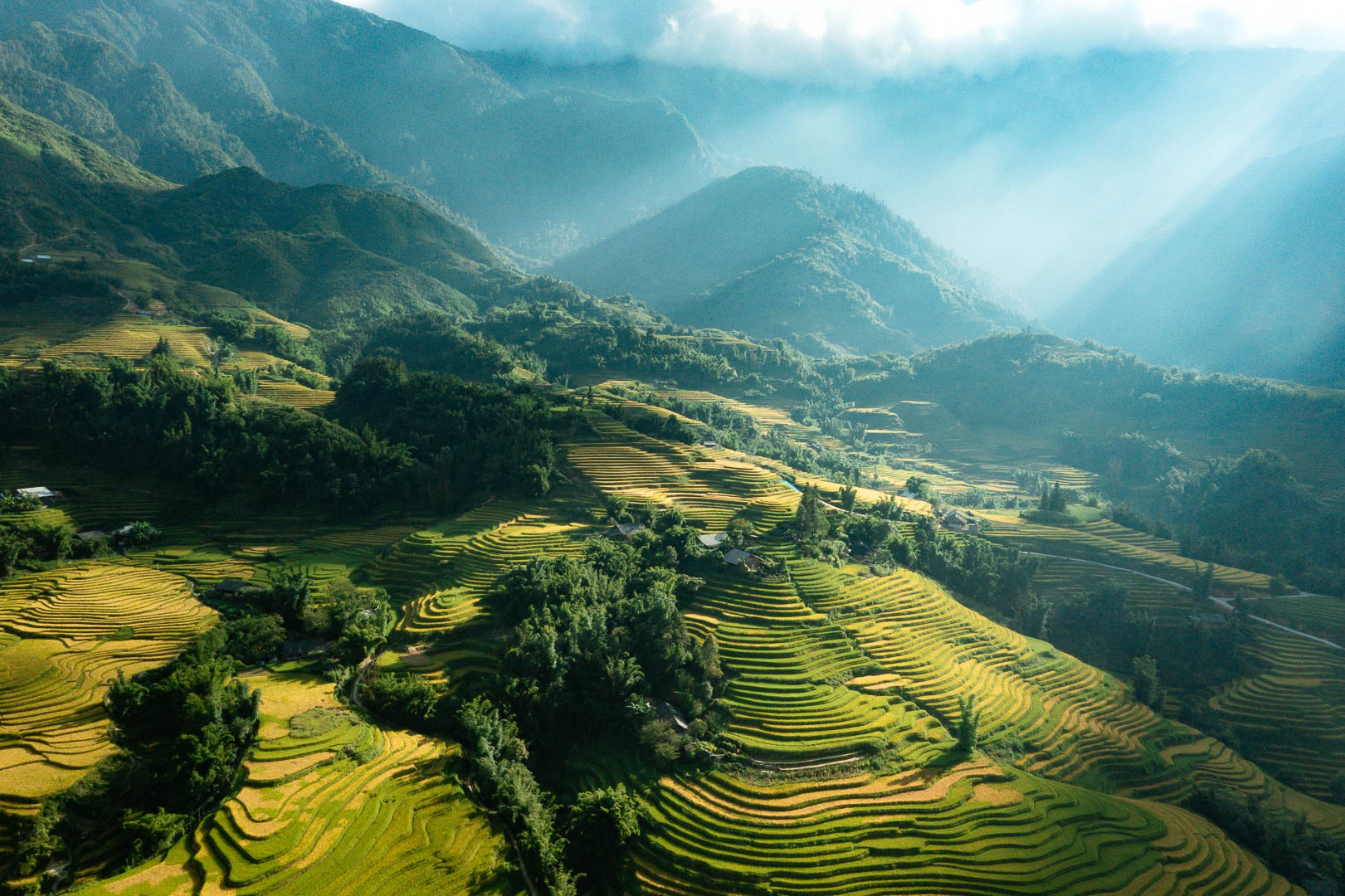


Referred to as the “City in the Clouds” by locals, Sapa is an enchanting treasure of the Northwest region of Vietnam. At first sight, the iconic scenery of cascading rice terraces, lush valleys, and verdant mountains standing side by side easily captivates visitors. Blessed with nature, it is no wonder that Sapa has become one of the most attractive destinations in the country.
Information Sapa Vietnam
Sapa is a beautiful mountain city in northern Vietnam, located in the Hoang Lien mountain range near the Chinese border. It is known for its beautiful scenery, vibrant culture, and unique hiking opportunities. Whether you are looking for a relaxing vacation or an adventurous getaway, Sapa has it all. This Sapa travel guide will give you everything you need to plan the perfect trip to this amazing destination. From the best places to stay and eat, to the best things to do and see, this guide will help you make the most of your time in Sapa.
Location
Sapa, located in Lao Cai province, northern Vietnam, is a beautiful destination that attracts many tourists with its pristine beauty and surrounding attractions in addition to famous attractions such as Ha Long Bay. and Hoi An Ancient Town. It offers trekking opportunities, lodges, and beautiful views of the mountains and rice terraces. No trip to Sapa would be complete without capturing the breathtaking beauty through your camera lens and using fun adjectives to describe the experience.
Since when is Sapa famous?
The mountainous city of Sapa was originally a hilltop refuge for French colonists desperate to escape the scorching heat of the Vietnamese plains. They chose the greatness of Fansipan. It’s easy to see why Hanoi loses its moisture as you ascend the mountain surrounded by emerald-green rice terraces. Since the French colonial period, the town of Sapa has been known for its cool climate, suitable for officers and soldiers to relax.
Sapa or Sa Pa is one of the most famous northern backpacking destinations in Vietnam. Nearby Mount Fansipan has an elevation of 3 meters above sea level and 143 meters above sea level, making it the highest point in Vietnam. Sapa has a cool climate, so the French turned it into the most famous mountain station in the early 1920s. Sapa tourism is a journey for visitors to understand the northern highlands of Vietnam. Spectacular terraces emerge, described as waterfalls.
It is one of the most spectacular mountain stations in Vietnam. It has a stunning landscape of mountains, forests, ethnic villages, and rice terraces. Visitors can visit Sapa town all year round and each place will bring different feelings and scenery
What ethnic groups are there in Sapa?
Around Sapa, visitors can encounter countless ethnic minorities. Visitors can encounter 24 ethnic groups in Sapa and Lao Cai, each with its language, culture, and traditions. This cultural wealth is due to the diversity of available landscapes and arable land. They are Kinh (Vietnamese) 35%, Hmong 22%, Tay 14%, Dao (Mien) 13%, Thai 9%, Nung 4.5%, and Giay (Dzay) 4.3%. Other ethnic groups Sapho and Lo Lo sometimes represent only a few villages and a few hundred people.
These places are mainly H’mong, commonly known as the Black H’mong, partly because their clothes are dark in color. They are almost black and decorated with colorful brocade and silver ornaments. But mainly because they are adorned with colorful brocade and silver ornaments.
The second largest group is the Dao, or Red Dao, who wears dark clothes. The largest known group of children is the Tao. They wore scarlet shawls decorated with silver beaded tassels, while the Nethermen wore distinctive headgear, braided hair, and long pins. Sterling silver protrudes on the crown.
They will happily take off their hats to show visitors that it’s just a hat and not their real hair. As they gleefully untie visitors and show them antiques and textiles. They are the true natives of the area. In addition, they see the political nonsense of the local people in the area.
Sapa is stratified and almost all the companies in town are owned and hired by Viet Kinh. The sole trade of the hill tribes was handicrafts, fruits, and vegetables on the road. The simple fact is that the tribe continues to live a very basic life, part economic, part cultural. For them, rice fields, gardens, a few cows, and houses on stilts are treasures they have coveted for perhaps hundreds of generations.
What is Sapa famous for?
Located in Lao Cai province, 350 km from Hanoi, Sapa is not only famous for its beautiful scenery but also for its diverse culture. During the French colonial period in the early 20th century, the French once considered Sapa as the summer capital of North Vietnam. Its natural landscape continues to attract more and more tourists coming here for vacation. This place is a top choice for honeymoon couples.
In addition, Sapa town has a cool climate, so it is increasingly becoming a summer resort for Vietnamese people.
In addition, these stilt houses are also very popular. Venture into remote villages, where you can catch a glimpse of a way of life that seems to have been stolen by history.
Sapa, known as the “Queen of the Mountains”, is a beautiful city in the North of Vietnam. Nestled on a plain, facing a beautiful valley, with towering mountains enveloping the town from all directions, it is the town that connects modern Vietnam with the mysterious world of cultures. minority nation. Hidden and stunning view.
Sapa is known for its beautiful yet rugged landscapes and rich cultural diversity. It is a picturesque leisure town located in the Hoang Lien massif in northwest Vietnam near the Chinese border; This massif is called the Tonkinese Alps. Sapa and the surrounding areas are home to many hill tribes and are home to the famous rice terraces, which were voted the most beautiful rice terraces in the world by the American magazine “Travel & Leisure”. These famous terraced fields flow down the mountain ridges like a canvas, creating an almost poetic image of terraced fields behind Fansipan Peak, the highest mountain in Vietnam.
From admiring the magnificence of the top of Fansipan mountain to the rare majestic beauty of the rice fields to experiencing the rare snowfall in Vietnam, Sapa offers you the most magical experiences yet. ever had. anywhere else in Vietnam.
What’s the weather like in Sapa?
Sapa’s climate is distinctly seasonal. The climate is subtropical in summer and temperate in winter. The average temperature in Sapa town is 15.4ºC, the maximum is 29.4ºC and the minimum is -7ºC.
Furthermore, Sapa experiences a distinct rainy season from May to September, with the heaviest rainfall occurring in July and August. The weather is also known for its frequent and rapid changes. It is said that only in Sapa can one experience many different seasons in one day.
March to May and September to November are the two best times to visit Sapa. Because it gives you a more relaxing, natural, and rejuvenating stay.
The winter is cold from November to March next year, with fog and light rain, the sky clears every 3 to 4 times, and the scenery is more beautiful than when it is clear. Sometimes there is ice and snow this time
No matter what time of year you visit, Sapa has its pros and cons.
Why is Sapa special?
Sapa is a famous high mountain town in Lao Cai province, Vietnam. This is a famous tourist attraction from the beginning of the 20th century to the present day. The Creator has bestowed Sapa with a mesmerizing watercolor painting. It is poetic and picturesque with undulating mountains, terraced fields, and vast pine forests. In the center of the city, silently witnessing the story of the Indochina peninsula…
Sapa has a year-round cool climate and unique local features – including the cultures of the two Sapa ethnic minorities, Mon and Tao – combined with a European architectural space. Classic Europe. All of the above factors create a special attraction for tourists who want to explore this land and book a trip to Hanoi Sapa right away.
Well, Sapa is not only a great destination with unique Vietnamese culture, cuisine, and local ethnic minorities, but also unique architecture. Its specialties are divided into two categories.
The first is the tradition of stilt houses of the local ethnic minorities, and the last is French architecture.
The traditional style of Sapa is most vividly expressed through the houses of the local ethnic minorities. Some of them are Thai, Nong, and Hmong. The design of stilt houses of different ethnic groups is different, but in general, the stilt houses of all ethnic groups are wooden architecture.
Tourists can visit ethnic villages such as Cat Cat, Lao Chai, Ta Van, Ta Phin, Giang Ta Chai, Y Linh Ho, etc, and see their stilt houses.
French architecture is mainly seen in the Sapa city center or neighboring areas such as stone churches and villas.
Traveling to Sapa, you will have the opportunity to experience the diversity of mountains and forests, and local people with different cultures and lifestyles. For the adventurous, Sapa is a great place to hike, climb and conquer Fansipan Mountain.
The morning in Sapa Town
What makes Sapa even more special is the rich culture of the local minorities, proud of their many customs and beliefs. Nestled in idyllic rugged valleys are hill tribe villages, inhabited by the Hmong, Dzao, and Tay ethnic groups that have settled here for hundreds of years while still being able to preserve their culture and their tradition. Wearing colorful ethnic costumes, enjoying ethnic dances, and ethnic songs, and feeling the local life, will be unforgettable experiences during and after your trip…
Best time to visit
Sapa is 1,560 meters above sea level and has a year-round subtropical climate. The town has four distinct seasons with an average temperature of 15.4°C.
The ideal time to explore this mountainous center is spring, which runs from March to May when wildflowers are in full bloom. Spring is also the time when hill tribes show off their unique culture through more than a dozen festivals. Coming to Sapa in April, you have a rare opportunity to experience 4 different seasons of Vietnam in one day.
From September to November, when the scorching summer ends, Sapa transforms into a little paradise for photography and tracking. The best time to photograph the terraces in Sapa is September. Sapa’s winter (December to February) is sometimes covered with thick white snow, offering adventurous travelers a rare opportunity. In a tropical high-tide country like Vietnam, this is a once-in-a-lifetime experience. Terraced fields in Sapa
The most suitable time to travel to Sapa: Sapa is cool all year round, you can experience four winters, summer, autumn, and spring in one day. However, the best time to visit Sapa is the terraced fields – Sapa.
Destination main attractions in Sapa
Fansipan Peak
Fansipan Peak is the top prominent destination in the Sapa travel guide for backpackers, not only the highest mountain in Vietnam but also the “roof of Indochina peninsula”. The breathtaking panorama of majestic mountains, lush valleys, and dense forests from the climbing boats truly challenges both amateur and professional hikers.
Muong Hoa Valley
Nestled in a mountain range of wonders, the unspoiled and quiet valley is known for its romantic beauty, unspoiled nature, and rich culture of local ethnic minorities, especially ancient rock beaches. , recognized as a unique Vietnamese Ancient Heritage, with hundreds of carvings scattered across ethnic grasslands and cascading terraces.
Bac Ha market
About 100 km from Sapa, Bac Ha is the largest ethnic market in Northwest Vietnam. Attracting thousands of ethnic groups from nearby hill tribes, it is a great place for indigenous people to meet and show off their colorful traditional ethnic costumes, giving visitors the chance ideal for exploring Sapa’s rich cultural diversity.
Sapa Love Market
Sapa Love Market is a cultural beauty and unique experience that visitors should not miss when coming to Sapa. Every Saturday night, the town comes alive with the charming hearts of Aboriginal boys and the glamorous dances of girls in colorful costumes. Not just a popular place where young minorities come to find a partner to get married.
Sapa love market is also an ideal place for people to organize cultural events, exchange goods and meet friends.
Tien Cave
The pristine and simple beauty of Tien Cave has attracted thousands of visitors at first sight. The turquoise waters of the Chay River surrounded by high cliffs turn this limestone cave into a beautiful corner of paradise. The Cave of Fairies looks like something straight out of a Grimm fairy tale.
The Heaven Gate
The Heaven Gate is located on the top of Tram Ton Pass in the Hoang Lien mountain range. About 18 km north of Sapa, this place has a great view of the valley between Fansipan, and the roof of the Indochina peninsula. As its name suggests, this destination offers a bit of a paradise, with breathtaking views of majestic mountains and incredibly deep abysses. Stepping up to heaven’s gate and enjoying the beautiful scenery of the winding mountain road below will be an unforgettable memory for those who have just set foot in Sapa.
Cat Cat village
Characteristic wooden houses, murmuring streams, exquisite brocade, and hospitable ethnic groups, the charming Cat Cat Village is the most beautiful old village in Sapa. Home to the H’mong ethnic group, this small village is home to a long tradition of residents cultivating flax and cotton and weaving beautiful brocade fabrics. When you come to Miao village, you can learn about the unique customs and habits of the Miao people through local life, while enjoying the hospitality of the locals while gaining a deeper understanding of the traditional culture of the Miao people. Miao people.
Most mentioned are the green rice fields and breathtaking mountain scenery of Sapa. This is a must-see and discover place in Sapa
Sapa City Center
Many hotels in the city center also offer visa arrangements, train tickets, and local Sapa tour packages for a surcharge. The town can get very crowded during high season, so reservations are recommended. Also, on weekends, prices can be a bit higher due to demand.
Which Place to Hacking in Sapa
Sapa is a beautiful mountainous region in northern Vietnam known for its beautiful scenery and diverse hiking trails. From easy hikes to challenging hikes, there is something for everyone in Sapa.
- Fansipan Peak: Fansipan Peak has an altitude of 3143 meters above sea level and is the highest peak in Indochina. It’s a challenging ride, but worth the view from above. The trail is marked and takes two to three days to complete.
- Cat Cat Village: This easy two-hour hike takes you through the stunning Cat Cat Village in Muong Hoa Valley. Along the way, you will pass rice terraces, traditional stilt houses, and waterfalls.
- Ta Phin Village: This moderate four-hour hike will take you through the stunning Ta Phin Village. Along the way, you will pass through lush forests, traditional stilt houses, and beautiful monasteries.
- Silver Falls: This easy two-hour hike will take you to the stunning Silver Falls. Along the way, you will pass through dense forests and traditional stilt houses.
- Y Linh Ho Village: This easy two-hour hike will take you through the stunning Y Linh Ho village. Along the way, you’ll pass lush forests, traditional stilt houses, and breathtaking waterfalls.
Whether you’re looking for an easy stroll or a challenging hike, this beautiful area has something for everyone
Where do you live in Sapa?
The foggy town of Sapa has a wide range of accommodation options, especially suitable for low- to moderate-income travelers, ranging from guesthouses and hotels to family-run homestays.
It also offers visitors many options to stay in luxury hotels. Styles and budgets vary, and most hotels in the area overlook the valley with stunning views of the Hoang Lien and Fansipan mountain ranges. Depending on your needs, you can choose to live in the city center/countryside accommodation. If convenience is your top priority, then a hotel in the city center is the right choice. Due to its ideal location, Sa Pa city center is a convenient base from which to explore the famous attractions around. For anyone looking for an outlandish experience and craving something a little more authentic, country-style accommodation would be the ideal choice. Just a 20-minute drive away, you’ll find quiet villages and homely inns with a completely different atmosphere.
It is a highland town in northern Vietnam. This destination has amazing natural beauty, beautiful hills, valleys, beautiful waterfalls, and above all colorful rice terraces. Therefore, when traveling to Sapa, you have a lot of options for accommodation, as you like with different scenery.
- Sapa town center
Happy to decide to choose a hotel in the center of Sapa town. Because of its central location, you can easily move to visit nearby tourist attractions. Most of the restaurants, shops, and night markets are also in Sapa town. Better to let you book any service and have options. There are many hotels in the center of Sapa, from budget to high-class, you can choose from.
- Muong Hoa Valley
For those who prefer to have a balcony in their room and enjoy mountain views, there are several hotels near Sapa. Some rooms overlook the Muong Hoa Valley with its beautiful rice fields and river. Sapa Unique HotelSapa Horizon Hotel, Sapa lodge hotel, Ham Rong Hotel, etc.
- Motel
This is why homestay is one of the best options for interacting with local minorities. Many villages such as Giang Ta Chai, Ta Van, and Ta Phin already have owners. If the budget is tight and there is no better way to experience the local culture, homestay is the best option. Homestay conditions are standard, so visitors must note this before traveling, if you expect amenities like a hotel, you will be disappointed.
What would you eat in Sapa?
There is a Sapa food court next to Sapa Central Plaza. It is located in front of Sapa stone church. The night is very lively, there are many grilled dishes, such as grilled eggs, grilled belly, grilled chicken, chestnuts, etc.
Visitors to Sapa especially should not miss delicious dishes such as rice and wild vegetables. Other types of wine such as Apple Meo wine, Ban Pho corn wine, grilled river fish, salmon, boiled corn… Ask the price in advance.
How to get from Hanoi to Sapa?
Due to its location in the northwest mountains, there is no airport nearby, so Sapa can only travel by road or rail.
Sapa town is only 38 km from Lao Cai and 376 km from Hanoi. You can go to Sapa by another vehicle
Take the local bus to Sapa
Thanks to the new Hanoi-Lao Cao highway, it only takes you 5 hours to travel from Hanoi to Sapa by shuttle bus. Ticket prices range from 220,000 to 450,0000 VND (about 10-20 USD). Because it is a bus route running directly into the urban area, visitors save a lot of travel time.
You can contact many different bus companies such as Sapa Express, Good Morning Sapa, and Hung Thanh..etc. This bus starts from the old quarter.
Sapa by train
There are different types of seats on board. Such as soft seats, hard seats, and air-conditioned beds… 9 am or 10 pm the train departs from Hanoi, and the next morning departs for Sapa. Regarding the type of chair, there are 2 types: hard chairs (about 150k/person) and soft chairs (about 280k/person). Regarding the type of bed, a bed for 6 people is about 480,000/person, a bed for 4 people is about 560,000/person, and a bed for 2 elderly people is about 3.2 million/person (both in Hanoi).
Note: Do not bring computers and valuable items when taking the night train to Sapa because it is very common to pickpocket when the lights are off. You should always carry your camera and phone with you.
ride a motorbike/scooter
Another way to get to Sapa is by motorbike or scooter, you need more than 10 hours. The road can offer spectacular views due to the rugged mountainous terrain, but it is not ideal for novice riders. Don’t forget that an international driver’s license is required to rent and drive a motorbike in Vietnam. Nighttime temperatures can get quite chilly during your trip, so be sure to bring some insulation in your luggage.
What should be prepared before going to Sapa?
You can go to Sapa all year round. However, you should dress warmly when traveling to Sapa during the winter months from December to February. Some areas of the room have electric blankets or heaters on the bed frames. However, this means that the rest of the room will be cold. So make sure that when you hand over your passport to the hotel, you will enter a room with a wood-burning fireplace.
Briefly
The Sapa travel guide is an invaluable resource for anyone looking to explore the beautiful and diverse land of Sapa. With comprehensive area information, detailed maps, and helpful tips and advice, it’s an essential tool for anyone planning a trip to this fascinating part of Vietnam. Whether you’re looking for a relaxing break or a vacation full of adventure, Origin’s tour team will help you make the most of your time in this amazing destination.
Above is the most complete and detailed Sapa travel experience compiled by Annie’s team. Hope these experiences will help you have a lot of fun and wonderful experiences when traveling in Sapa.
If you need any support to make a plan for your trip for free, please contact Annie’s team:
- Email: info@annie.vn
- Whatsapp: +84969043106
How To Get from Sapa To Hanoi For Traveller
On the 315km journey from Sapa to Hanoi, you have 3 options: 9 hours by
Bac Ha Market In Sapa Vietnam & Best Things To Do
Bac Ha market is known as the largest and most beautiful market in the region.
Best Sapa Adventure Package Tour 6 Days 5 Nights
Sapa trekking for 6 days is a tough journey to explore different villages. You will
The Best Famous Muong Hum, Y Ty Package Tour 2 days 1 night
You are a lover of photography in the clouds. Muong Hum village, Y Ty village
Full-Day Walking Tour To Cat Cat, Lao Chai And Ta Van Villages
Full-Day Tour Trek Cat Cat Villages to Lao Chai and Ta Van The full-day trip
Bac Ha Market Hiking & Homestay 2 Days 1 Night Package
Explore the charm of the remote villages of Ban Pho, Na Lo, Thai Giang Pho,
The Best Tour package In Thanh Phu And Sin Chai Villages
Sapa Trek Thanh Phu and Sin Chai village Duration: 2 days 1 night Sapa→ Thanh
The best Sapa Trekking and Homestay Service 3 days (SP3d)
The three-day itinerary will take you to different villages in the Cat Cat Valley and
Fansipan Mountain Detail Travell Guideline 2023
At an altitude of 3,143m above sea level, Sapa is home to Fansipan Mountain. The
- 1
- 2

